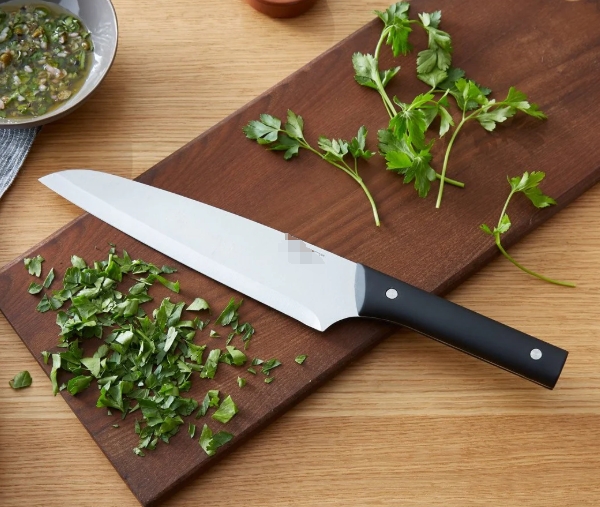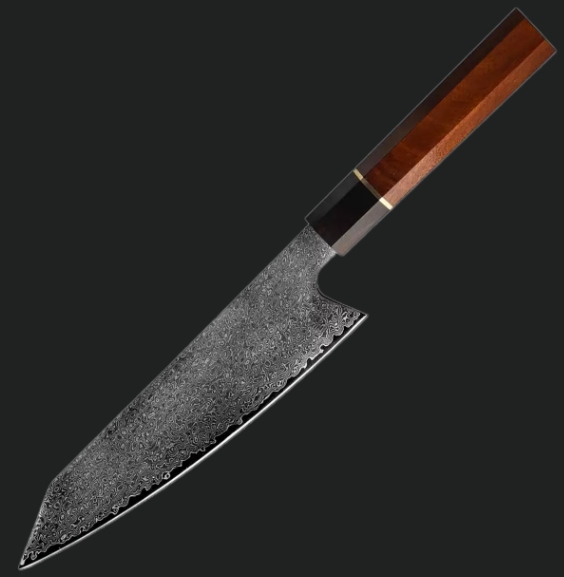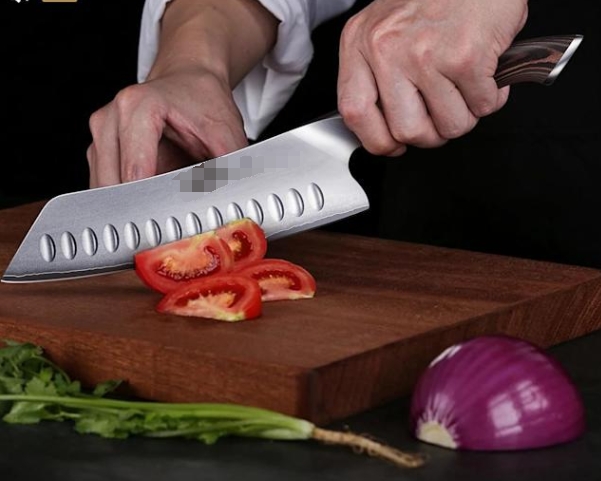

Views: 222 Author: Ella Publish Time: 2025-05-02 Origin: Site








Content Menu
>> Key Features of Forged Knives
>> Advantages of Forged Knives
>> Key Features of Stamped Knives
>> Advantages of Stamped Knives
● Forged vs. Stamped: A Detailed Comparison
● How to Decide Which Knife Is Right for You?
>> Consider Your Cooking Style
>> Budget
>> Maintenance
● The Importance of Steel Quality in Forged and Stamped Knives
● Handle Materials and Their Impact on Knife Performance
>> Wood Handles
● Ergonomics and Balance: Why They Matter
● Maintenance Tips for Forged and Stamped Knives
>> Cleaning
>> Sharpening
>> Storage
● FAQ
>> 1. What is the main difference between forged and stamped knives?
>> 2. Which knife type holds its edge longer?
>> 3. Are forged knives harder to maintain?
>> 4. Is a stamped knife suitable for professional use?
>> 5. Can I sharpen both forged and stamped knives at home?
Choosing the right chef knife is crucial for any kitchen enthusiast or professional cook. Among the many options available, the decision often boils down to two main types: forged and stamped knives. Each has distinct manufacturing processes, characteristics, and advantages that affect performance, durability, and user experience. This comprehensive guide will help you understand the differences and make an informed choice tailored to your cooking needs.

A forged knife is crafted from a single solid bar of steel. The steel is heated until it becomes red-hot and malleable, then hammered or pressed into shape. This process is often done by skilled craftsmen or precision machinery and is followed by heat treatment steps like quenching and tempering to harden and strengthen the blade.
- Full Tang and Bolster: Forged knives typically have a full tang, meaning the steel extends through the entire handle, providing excellent balance and durability. They also often feature a bolster-a thick junction between the blade and handle-which adds weight, balance, and acts as a finger guard.
- Weight and Thickness: Forged knives are usually thicker and heavier than stamped knives, offering a solid, sturdy feel that helps with powerful cuts and precision.
- Edge Retention: The forging process, combined with heat treatment, produces a blade that is harder and holds a sharp edge longer than stamped knives.
- Durability: The dense, compressed steel structure from forging results in a blade that resists bending, warping, and chipping, making it ideal for heavy-duty kitchen tasks.
- Exceptional balance and weight distribution reduce hand fatigue and improve control.
- Superior strength allows for precise, powerful cuts through tough ingredients.
- Bolster provides safety and comfort during extended use.
- Longer-lasting sharpness reduces the frequency of sharpening.
- Full tang construction enhances stability and durability.
Stamped knives are produced by cutting the blade shape out of a large sheet of steel using a machine, similar to a cookie cutter. After stamping, the blade undergoes processes like honing and heat treatment to improve sharpness and durability.
- Lightweight and Thin: Stamped knives are thinner and lighter, which can make them easier to handle for some users, especially during repetitive slicing tasks.
- No or Partial Bolster: Most stamped knives lack a bolster, which means less weight and balance but more blade exposure for sharpening.
- Tang Variations: They may have a partial tang or no tang, which can affect the knife's strength and balance.
- Flexibility: Stamped blades tend to be more flexible, which can be beneficial for delicate slicing but less ideal for heavy chopping.
- Lightweight design reduces fatigue during prolonged use.
- Typically more affordable, making them accessible for beginners or casual cooks.
- Thin blades allow for easy slicing and maneuverability.
- Easier to sharpen along the entire blade edge due to the absence of a bolster.
| Feature | Forged Knives | Stamped Knives |
|---|---|---|
| Manufacturing | Heated and hammered from a single steel bar | Cut from large steel sheets |
| Weight | Heavier and thicker | Lighter and thinner |
| Balance | Excellent with full tang and bolster | Less balanced, often partial or no tang |
| Edge Retention | Holds edge longer due to harder steel | Dulls faster, requires frequent sharpening |
| Durability | More durable, resists bending and chipping | More flexible but less durable |
| Safety | Bolster acts as finger guard | No bolster, higher risk of finger slips |
| Price | Generally more expensive | More affordable |
| Ease of Sharpening | Sharpening easier due to rigid blade | Easier to sharpen along entire edge |
| Use Case | Heavy-duty cutting, professional kitchens | Light slicing, casual or beginner cooks |
- Heavy-Duty Tasks: If you frequently cut through tough vegetables, meat, or use a rocking motion, a forged knife's weight and balance will provide better control and power.
- Light and Precise Cutting: For delicate slicing or prolonged use without fatigue, a stamped knife's lightweight and flexibility might suit you better.
Forged knives require more labor and higher-quality materials, resulting in a higher price. Stamped knives offer a budget-friendly alternative without sacrificing initial sharpness.
Forged knives, often made from high-carbon steel, may require more careful maintenance to prevent rust but hold their edge longer. Stamped knives, usually stainless steel, are easier to maintain but need more frequent sharpening.
Try handling both types if possible. The feel, balance, and grip comfort are highly personal and can influence your choice more than specifications.
Beyond the manufacturing process, the type of steel used plays a significant role in the knife's performance. Both forged and stamped knives can be made from various steel grades, including stainless steel, high-carbon steel, or specialized alloys.
High-carbon steel is favored for its ability to be hardened to a greater degree, which improves edge retention and sharpness. Forged knives often use high-carbon steel, making them sharper and longer-lasting but more prone to rust if not cared for properly.
Stainless steel contains chromium, which makes the blade resistant to rust and corrosion. Many stamped knives use stainless steel, which is easier to maintain but may not hold an edge as long as high-carbon steel.
Some high-end forged knives use powder metallurgy steel, which offers superior hardness, edge retention, and corrosion resistance. This steel is more expensive but provides excellent performance for professional chefs.

The handle is as important as the blade in determining comfort, safety, and control. Both forged and stamped knives come with various handle materials, each with unique benefits.
Wood handles provide a traditional look and comfortable grip. They can absorb moisture, so they require proper care to avoid cracking or warping. Wood handles are common in forged knives.
Materials like polypropylene, resin, or composite offer durability, water resistance, and ease of maintenance. Stamped knives often feature synthetic handles, making them practical for everyday use.
These are high-quality composite materials used in premium knives. They offer excellent grip, durability, and resistance to moisture and temperature changes, often found in forged knives.
A well-balanced knife reduces hand fatigue and improves precision. Forged knives generally have superior balance due to the full tang and bolster, distributing weight evenly between the blade and handle. This balance allows for smoother rocking motions and controlled cuts.
Stamped knives, being lighter and thinner, may feel less balanced, especially during heavy chopping. However, for users who prefer a lighter tool or have smaller hands, stamped knives can offer better maneuverability and less strain.
Proper care extends the life of any knife, whether forged or stamped.
- Always hand wash knives immediately after use with mild detergent and warm water.
- Avoid soaking knives or putting them in the dishwasher, as this can damage the blade and handle.
- Use a whetstone or professional sharpening service for forged knives to maintain their edge.
- Stamped knives can be sharpened at home with sharpening rods or electric sharpeners, but care must be taken to avoid over-thinning the blade.
- Store knives in a knife block, magnetic strip, or blade guard to protect the edge and prevent accidents.
Choosing between a forged and stamped chef knife depends on your cooking habits, budget, and personal preferences. Forged knives offer superior durability, balance, and edge retention, making them ideal for professional chefs and serious home cooks who value precision and long-term investment. Stamped knives provide lightweight handling, affordability, and ease of use, suitable for casual cooks or those new to kitchen knives.
Investing in a forged knife enhances your cooking experience with powerful, precise cuts and lasting sharpness. However, stamped knives remain a practical choice for everyday slicing tasks and lighter kitchen work. Ultimately, the best knife is one that feels comfortable in your hand and meets your specific culinary needs.

Forged knives are made by heating and hammering a single piece of steel into shape, resulting in a thicker, heavier, and more balanced blade with a bolster and full tang. Stamped knives are cut from large sheets of steel, are thinner and lighter, often lacking a bolster and having a partial tang.
Forged knives typically hold their edge longer due to the forging and heat treatment process that hardens the steel, making them more durable and less prone to dulling quickly.
Forged knives, especially those made from high-carbon steel, require more care to prevent rust and corrosion but benefit from longer-lasting sharpness. Proper cleaning and regular honing are essential.
While stamped knives can be sharp and effective, they are generally less durable and balanced than forged knives, making forged knives the preferred choice for professional chefs who need reliable, long-lasting tools.
Yes, both types can be sharpened at home. Forged knives may be easier to sharpen due to their rigidity, while stamped knives' thinner blades require careful sharpening to avoid bending. Avoid electric sharpeners that can damage blades.